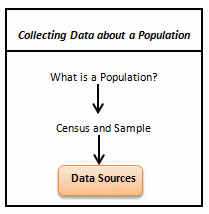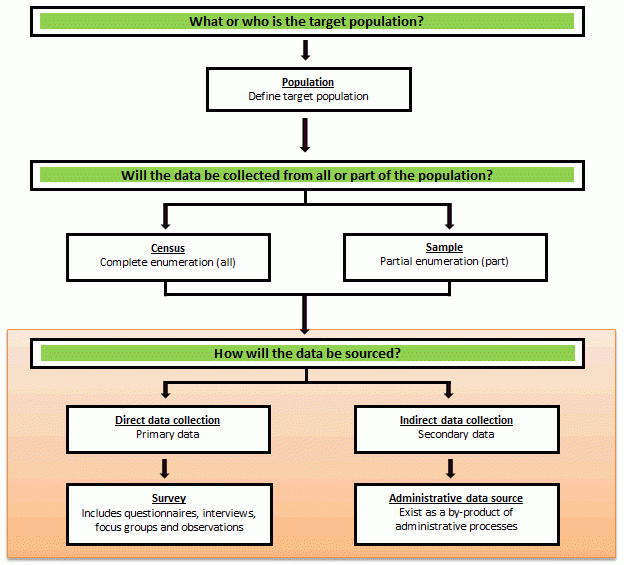Data sources
Recommended: First read Census and Sample
Methods of sourcing data
Data can be sourced directly or indirectly.
Direct methods of data collection involve collecting new data for a specific study. This type of data is known as primary data.
Indirect methods of data collection involve sourcing and accessing existing data that were not originally collected for the purpose of the study. This type of data is known as secondary data.
Sourcing direct data
A survey involves collecting information from every unit in the population (a census), or from a subset of units (a sample) from the population.
A respondent provides data about oneself as a unit, or as a representative of another unit in a population.
Methods of direct data collection include:
- Surveys administered through the use of an interviewer
- Surveys which are self-enumerated (the information written or entered directly by the respondent)
- In depth interviews or focus groups to provide the opportunity for discussion and elaboration for collecting more detailed information about a particular issue or issues
- Observational studies in which data are gathered through the direct observation of the population or sample
- Experiments and clinical trials that involve controlled studies where researchers collect data from subset groups taken from the population of interest.
Sourcing indirect data
Administrative data are collected as part of the day to day processes and record keeping of organisations. Administrative data, such as historical data or public records, include: school enrolments; hospital admissions; records of births, deaths, and marriages. The data are not collected initially for statistical purposes but can be organised to produce statistics.
Administrative data can be useful because this data are usually recorded about every unit of the population of interest and are continuously collected, allowing comparisons to be made over time. Where administrative data are available, this may eliminate the need to conduct a survey provided the data are fit for the statistical purpose.
Collecting data about a population
Step 3 - Data sources
Image

Description
Flowchart of the 3 steps when collecting data about a population. Step 1 - What is a population? Step 2 - Census or sample Step 3 - Data sources (This step talked about on this page)
Collecting data about a population flowchart
Image

Description
What or who is the target population? Define target population. Will the data be collected from all or part of the population? If doing a complete enumeration (all), a census is conducted. If only doing a partial enumeration (part), a sample is taken. How will the data be sourced? If collecting primary data in a direct data collection, a survey is conducted. This includes questionnaires, interviews, focus groups and observations. If collecting secondary data in an indirect data collection, an administrative data source can be used. This data exists as a by-product of administrative processes. (This step talked about on this page)